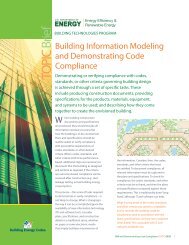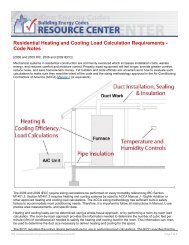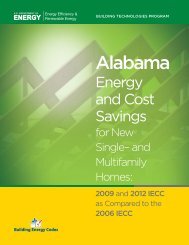Shaping the Energy Efficiency in New Buildings - Building Energy ...
Shaping the Energy Efficiency in New Buildings - Building Energy ...
Shaping the Energy Efficiency in New Buildings - Building Energy ...
You also want an ePaper? Increase the reach of your titles
YUMPU automatically turns print PDFs into web optimized ePapers that Google loves.
accord<strong>in</strong>g to <strong>the</strong> current codes. This <strong>in</strong>itiative also <strong>in</strong>cludes a goal to monitor and <strong>in</strong>crease<strong>the</strong> compliance level at <strong>the</strong> state level to 90%.2.8 SummarySome of <strong>the</strong> important highlights <strong>in</strong> <strong>the</strong> development of build<strong>in</strong>g energy codes <strong>in</strong> APPcountries <strong>in</strong>clude <strong>the</strong> follow<strong>in</strong>g:a) Australia has updated its build<strong>in</strong>g energy codes annually s<strong>in</strong>ce 2003.b) Build<strong>in</strong>g energy codes <strong>in</strong> Canada and India were highly <strong>in</strong>fluenced by <strong>the</strong>structure and development process of <strong>the</strong> United States ASHRAE 90.1 standard.c) Australia, Canada, Ch<strong>in</strong>a, Japan and <strong>the</strong> United States have both commercial andresidential build<strong>in</strong>g energy codes, while India has a build<strong>in</strong>g energy code for largebuild<strong>in</strong>gs. Ch<strong>in</strong>a’s residential and commercial codes also cover only largebuild<strong>in</strong>gs. South Korea’s build<strong>in</strong>g codes cover both commercial and residentialbuild<strong>in</strong>gs <strong>in</strong> <strong>the</strong> same document. 27d) The United States was <strong>the</strong> first APP country to develop both residential andcommercial build<strong>in</strong>g codes <strong>in</strong> 1975.3 Comparison of <strong>the</strong> Structure and Requirements ofBuild<strong>in</strong>g <strong>Energy</strong> Codes3.1 Structural ComparisonThe topics that codes cover vary across countries. With<strong>in</strong> <strong>the</strong> APP region, <strong>the</strong> Englishspeak<strong>in</strong>gcountries have codes that cover fairly similar issues, while <strong>the</strong> East Asiancountries each have unique codes cover<strong>in</strong>g different sets of issues. The United States,Canada and India all have build<strong>in</strong>g energy codes developed from or based on ASHRAEstandards. The Australian build<strong>in</strong>g energy code, while not directly patterned afterASHRAE, does approach build<strong>in</strong>g energy requirements <strong>in</strong> a fairly similar manner. Thebuild<strong>in</strong>g energy codes <strong>in</strong> Australia, Canada, India and <strong>the</strong> United States all address suchbuild<strong>in</strong>g components as build<strong>in</strong>g envelope, HVAC, light<strong>in</strong>g, service hot water, electricalpower and <strong>the</strong> build<strong>in</strong>g performance approach. Commercial build<strong>in</strong>g energy codes oftenprovide more detailed and str<strong>in</strong>gent provisions than residential build<strong>in</strong>g energy codes thattarget s<strong>in</strong>gle-family homes (except for India, which has only one code for large build<strong>in</strong>gs).The codes <strong>in</strong> East Asia are less homogenous compared to those described above. Ch<strong>in</strong>a’sbuild<strong>in</strong>g energy codes are focused on <strong>the</strong> build<strong>in</strong>g envelope and HVAC; light<strong>in</strong>g iscovered <strong>in</strong> a separate document. In Japan, <strong>the</strong> residential and commercial energy codeshave very different structures and compliance paths. Both Ch<strong>in</strong>a and Japan have detailedresidential build<strong>in</strong>g energy codes but <strong>in</strong> Ch<strong>in</strong>a <strong>the</strong> code covers only large residential27 BDCES focuses on large-scale build<strong>in</strong>gs, but South Korea’s RBFCO applies to all build<strong>in</strong>gs regardlessof <strong>the</strong>ir size. It is mandatory and provides requirements for m<strong>in</strong>imum U-values, air tightness of build<strong>in</strong>gand o<strong>the</strong>r issues for all commercial and residential build<strong>in</strong>gs.30
















